To get my miles in today, I ran to Casey’s, loped around the course in 33:48, and then ran back home. I would have missed the SRR chicken wing contest by running home instead of hanging out in the bar after the race, but the contest was postponed until next week. Spicy chicken wings just before bedtime aren’t going to help me sleep, but when it comes to free food, I am weak.
I didn’t have any blisters when I got home. Thankfully, that’s not unusual these days. I’ve finally figured out how to battle the blisters to a draw. As long as I pay attention, I almost always finish my run with the same amount of skin as I started with.
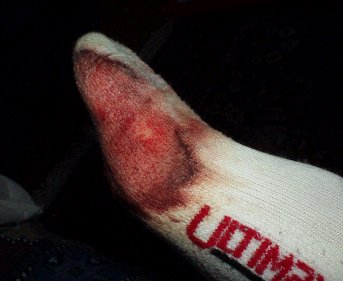 My right foot is turned out so much that I’m forced to toe-off the side of the ball of my foot when I run. That puts an extraordinary amount of force on a very small area and also grinds my big toe against the rough stitching and seams on the side of my shoe’s toebox. If I go out without any protection, even if it’s only for a short run, I will get blisters. And for years, I’d always come home with blisters after a long run, no matter what I tried.
My right foot is turned out so much that I’m forced to toe-off the side of the ball of my foot when I run. That puts an extraordinary amount of force on a very small area and also grinds my big toe against the rough stitching and seams on the side of my shoe’s toebox. If I go out without any protection, even if it’s only for a short run, I will get blisters. And for years, I’d always come home with blisters after a long run, no matter what I tried.
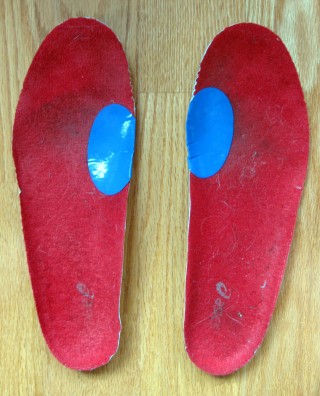 I’ve stuck all sorts of elaborate patches and gunk to my feet to try and protect them from the friction of running. Then I read a recommendation in Marshall Ulrich’s book for Engo patches. Now, I stick an Engo on each insole at the ball of my foot. The patch has a slick surface that reduces the friction between my foot and my shoe. They last a long time, and they make a big difference. I hardly have to worry at all about my left foot anymore, and the patch works with the things I use to protect my right foot to make blisters a rare occurrence.
I’ve stuck all sorts of elaborate patches and gunk to my feet to try and protect them from the friction of running. Then I read a recommendation in Marshall Ulrich’s book for Engo patches. Now, I stick an Engo on each insole at the ball of my foot. The patch has a slick surface that reduces the friction between my foot and my shoe. They last a long time, and they make a big difference. I hardly have to worry at all about my left foot anymore, and the patch works with the things I use to protect my right foot to make blisters a rare occurrence.
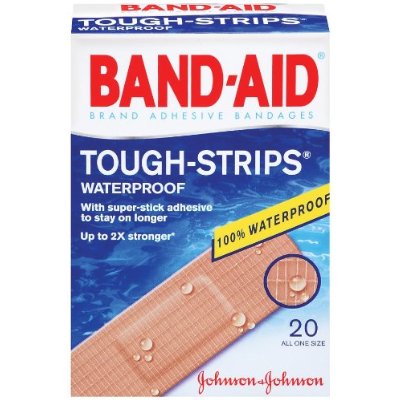 Once I got the Engo patches, I found that I did quite well with simple Band-Aid Tough Strips. Tough Strips use a stronger adhesive than regular bandaids. I tried to save a few bucks by using store brands, but the name brand adhesive is a lot more reliable. The flexible fabric Tough Strips work well enough for shorter runs, but when I need more protection on my right foot, I use a waterproof Tough Strip to hold the fabric strip down and cover more of the surface of my foot. The waterproof Tough Strips are especially hard to peel off. The Tough Strips don’t always stay stuck to my foot, but they stay stuck to each other and the pocket that makes tends to stay in place and continue protecting my foot.
Once I got the Engo patches, I found that I did quite well with simple Band-Aid Tough Strips. Tough Strips use a stronger adhesive than regular bandaids. I tried to save a few bucks by using store brands, but the name brand adhesive is a lot more reliable. The flexible fabric Tough Strips work well enough for shorter runs, but when I need more protection on my right foot, I use a waterproof Tough Strip to hold the fabric strip down and cover more of the surface of my foot. The waterproof Tough Strips are especially hard to peel off. The Tough Strips don’t always stay stuck to my foot, but they stay stuck to each other and the pocket that makes tends to stay in place and continue protecting my foot.
I tried using an Engo where my big toe rubs on the side of my toebox, but it didn’t stick there as well as it does on the insole, and when an Engo peels off, the glue it leaves behind causes extra problems. Instead, I use large FootSmart toe caps to protect my big toe. They’re three for $15, but each one lasts for weeks.
Of course, the basics still matter. Blister protection starts with shoes that fit properly. It’s also important to have the right socks. A good sock wicks away as much sweat as possible and provides some additional protection against friction without adding more seams or lumps for my foot to rub against. My favorites are Wigwam Ultimax Ironman Triathlete socks. Not only do they work well, but they last forever. I’ve never had a pair wear out, though I have had to throw some away after they got too encrusted with adhesive from the things I’ve stuck to my feet.
Even with everything else I do, my foot still tries to protect itself by building calluses, but when they get too thick, they do more harm than good. Instead of protecting me, a thick callus is just one more lump grinding against the soft skin underneath. There’s nothing worse than a big blister buried deep under a thick callus. It’s like having a pothole torn in my foot.
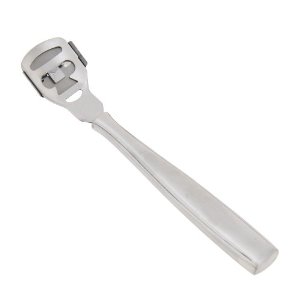 So I keep my calluses trimmed. My callus shaver has a little razor blade that slices right through the thick layers of callus. If I shave my calluses regularly, that does a lot to reduce the blisters. The trick is to avoid shaving the calluses too close. It’s easy to remove too much and eliminate the protection they provide. And if I’m not careful, it’s easy to slice past the callus and draw blood, which can be just as bad as a blister.
So I keep my calluses trimmed. My callus shaver has a little razor blade that slices right through the thick layers of callus. If I shave my calluses regularly, that does a lot to reduce the blisters. The trick is to avoid shaving the calluses too close. It’s easy to remove too much and eliminate the protection they provide. And if I’m not careful, it’s easy to slice past the callus and draw blood, which can be just as bad as a blister.
It takes a lot of maintenance to stay blister-free, but it’s worth it. I’m much happier when I’m using my pins to hold bib numbers, and not for popping blisters.
(11.9 mi. run; 147.5#)

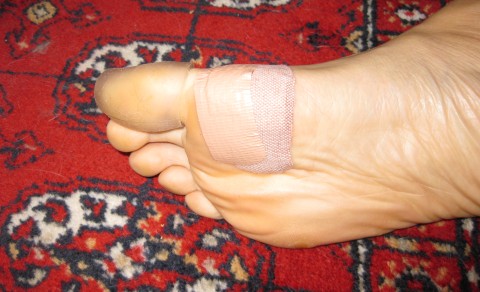
Pingback: CCM Diary: Lined Up « Y42K?
Pingback: CCM Diary: Something I Learned Today « Y42K?